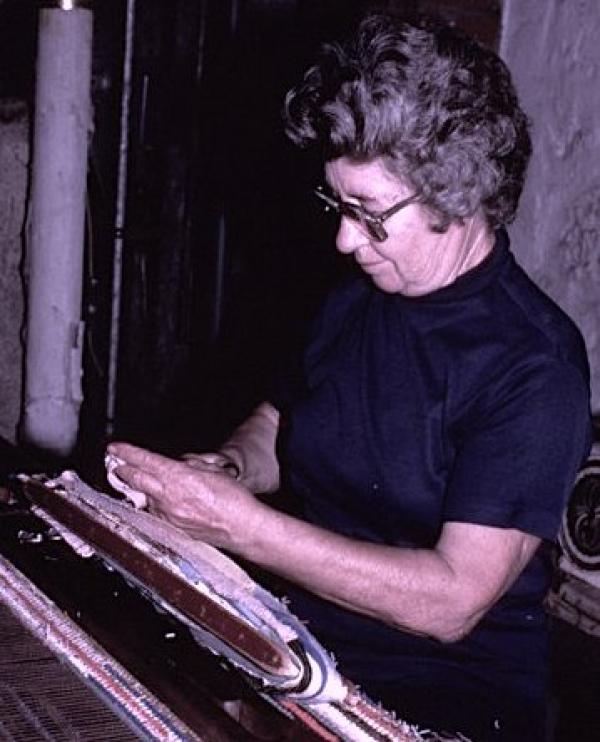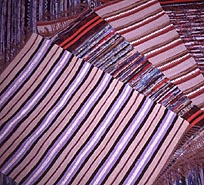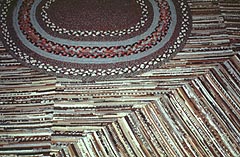Dorothy Trumpold

Photo ourtesy of the artist
Bio
Dorothy Trumpold of East Amana, Iowa, has been weaving rugs for nearly 60 years. She watched her grandfather prepare his loom when she was 8 years old in 1920. The Amana Colonies, where she has resided for her entire life, have a unique social and religious history. Settlers of these communities came originally from Germany and were members of the Community of True Inspiration, a Lutheran sect founded in 1714 and based on the belief that God may communicate through an inspired individual. This group moved first to Ebenezer, New York and then traveled to Iowa in 1855 where it established a communal lifestyle in seven villages located on 26,000 acres of farmland. Each village had its own tinsmith, cobbler, basketmaker and furniture maker, while a calico printing factory and two woolen mills served the entire community. This communal way of life, often mistakenly confused with the Amish or Mennonites, existed until 1932, when the residents chose to relinquish their communal forms of property ownership in what is still called "the Great Change." Dorothy Trumpold is one of the few craftspeople left who represents a link with the old way of life. Her rugs and carpets, which she still weaves on a loom brought to America in the 1840s, exhibit her precise sense of design and her striking textural and chromatic sensitivity. Two of her specialties, the whole house carpet and the stairway carpet, require a mastery of the medium and an exacting consistency in execution. Her carpets continue to serve the Amana residents in a functional and artistic sense. She has taken it upon herself to pass along these skills to younger people in the community. She says of her long career: "I never advertised, but somehow people found out and I got busy right away and have been busy ever since."
 |
 |
Interview with Victoria Hutter
NEA: Congratulations on your award. Tell me about how you wove in the early days.
MS. TRUMPOLD: In the first years, that I in the '40s, it was mostly cotton. People here could have their rags dyed at the mill. They'd always be brown, light brown and dark brown, and then there'd be a colored stripe. People sewed the rags together into strands and they would throw them into the dye. When the rags were dry, people made them into balls and brought them to me to weave.
Later on, after they could buy the mill ends, then they got to make the woolen carpets. Each piece of wool had a number on it that was either sewn in or painted on, then it was cut off when it was sold. The mills sold those pieces by the pound. They could be bought for 50 cents a pound and people could cut it into strips and have carpets made from it.
You usually made it in a hit and miss pattern. You couldn't buy a specific color - you had to buy whatever materials they were making then and put in sacks. You just bought it by the sack. It's called hit and miss pattern is because there's always a little bit of each color left that maybe wasn't enough to start anything else. You always sewed them in to get a mixed up pattern. I made a lot of those.
NEA: Where do your materials come from now?
MS. TRUMPOLD: The warp is the set of threads that holds the rags together in the carpet. I get warp from Kentucky. It's about the only place you can get it now. I used to order it from Sears but they don't handle it anymore. And people bring me rags, old clothes they don't use anymore. I take the best part of those. Test them to be sure they're strong enough and will last.
The other day I began thinking about how many times I've been asked to estimate how many yardcs I've woven. I've never sat down to count them because it was quite a job. One day recently, when I didn't have much to do, I sat down and I counted all the many times I rewarped the machine, put the fresh warp on. I went all through all of the years - I have three record books - and I counted all the times I put the fresh warp on and the yards I put on. It came to 13,710 yards.
NEA: Who or what were the most important influences in your career? Who helped you and who inspired you?
MS. TRUMPOLD: Nobody helped me. I inherited my grandfather's loom. He used to do the weaving here in East Amana. It was an old, old loom that they brought over from Germany when the mill started. There was a fire in 1923, and the wooden parts were burnt. But the cast iron was still OK so they fixed it so he could weave carpets.
NEA: So you learned from him?
MS. TRUMPOLD: No, he was in his 80s and got sick and couldn't do it anymore. He always wanted someone to do it, so more or less to satisfy him I tried it. He had some rags here from some people that he was supposed to use, so I used those rags. But he wasn't there to see it anymore. I learned by myself. I had watched him. As far as the weaving, it's really easy. It's just a two-heddle wheel loom. Just up and down. I pushed the peddles with my feet to get the heddles up and the other ones down. [Heddles are where the thread runs through the warp.]
NEA: Who are you weaving for now? Where are your rugs going?
MS. TRUMPOLD: I am just weaving throw rugs and they sell them for me at the Arts Guild in Amana and at the woolen mill in Amana. And I made one for the Des Moines Arts Center.
NEA: Are you working with students and passing on what you have learned over all of these years?
MS. TRUMPOLD: Well, there's one girl here who goes to 4-H every year or to the fair. For the last four years now she's made a rug on my loom and taken it to the fair. I think she's won a ribbon every time.
NEA: And she hopes to continue?
MS. TRUMPOLD: I don't know. That I doubt. Young people now, there's just not enough money. It's just more or less a hobby.
NEA: Do you know a lot of weavers?
MS. TRUMPOLD: No, not really. There were some gals once from Waterloo and Cedar Falls that had a kind of a club. They were interested and came to see me. And a gal from Ames I helped. She actually took it in college but she wanted to know the Amana ways, so she came to Amana and wanted to learn the way we do it here. I just did my own weaving and was busy all the time.
NEA: I was interested in the history of your community. And what was life like before the Great Change?
MS. TRUMPOLD: I cooked in one of the kitchens for five years before the Change. It was quite a change. The young people liked it, most of them. But the older people, some of them who had worked in the gardens and not done any cooking at home didn't like it so well. Some of them anyhow. So they had to learn to cook. It was quite a change.
NEA: Are there parts of it that you would like back?
MS. TRUMPOLD: No, not really. It was very church-oriented. Church three times on Sunday and then every night and then Wednesday mornings and Saturday mornings.
NEA: What are the biggest challenges for you in practicing your art?
MS. TRUMPOLD: I don't do too much anymore. You know in a few weeks I'll be 89 and I can't be working too hard anymore.
NEA: And what will happen to that wonderful loom?
MS. TRUMPOLD: It's still in my basement. I rewarped it in April and when I was done I fell and broke my thumb. I couldn't do any weaving for quite some time. I had it in a stint for almost five weeks, so I couldn't do too much. But now I'm doing it again. Just throw rugs, not room size. I don't think I'll be doing it too much longer, to tell you the truth.
NEA: What are you looking forward to most when you come to Washington for the ceremony and performance?
MS. TRUMPOLD: I was there in 1996 for the Smithsonian Folklife Festival and I saw most of the interesting things around Washington then. But I think it will be very interesting to meet the other winners. I just hope I can make it.

